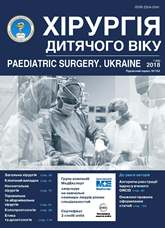Experience of surgical treatment of pectus excavatum in children
DOI:
https://doi.org/10.15574/PS.2018.58.81Keywords:
pectus excavatum, thoracoplasty, childrenAbstract
Pectus excavatum is the most common thoracic wall deformities. This anomaly manifests itself as a cosmetic defect as well as cardiovascular and respiratory functional disorder. Its characteristic feature is the tendency towards progression, which is closely related to the child’s growth and age.Objective – a comparative characteristic of the retrosternal and thoracoscopic control of metal struts conduction during thoracoplasty of pectus excavatum (PE) according to D. Nuss.
Material and methods. There 50 children aged from 4 to 17 years with PE were examined and treated. The symmetrical form of deformation was observed in 33 (66%) patients, asymmetric – in 10 (20%) cases, and flat-shaped – in 7 (14%) children. Preoperative examination included general clinical lab tests, spirography, electrocardiography, echocardiography, chest X-ray examination in direct and lateral projections, and computed tomography. All patients underwent thoracoplasty according to D. Nuss.
Results. All patients were followed up after the surgery to observe surgical outcomes. Good results were obtained in 43 (86%) cases, satisfactory – in 6 (12%) children, and unsatisfactory outcome was in 1 (2%) patient.
Conclusions. Surgical correction of PE by using retrosternal metal struts is a perspective direction of thoracoplasty, which has advantages over resection techniques (minimally invasive with good cosmetic outcomes), and thoracoscopic technique increases safety and reduces the traumaticity of surgical intervention.
References
Guba AD. (2007). Operative treatment of funnel-shaped deformation of the chest in children and adolescents: Abstract of the dissertation. dis … cand. honey. sciences. Kurgan: 18.
Krivchenya DYu, Pritula VP, Kuzik AS. (2011).Variants of the Nuss operation modification in the correction of the funnel-shaped deformation of the chest: advantages and disadvantages. Pediatric Surgery. Ukraine. 1: 27-30.
Malakhov OA, Zherdev KV, Chelpachenko OB. (2011). Orthopedic aspects and features of surgical treatment of funnel-shaped deformity of the thorax in children and adolescents Bulletin of Traumatology and Orthopedics. N.N. Priorova. 3: 3-9.
Plyakin VA, Kulik IO, Sarukhanyan OO. (2013). Comparative evaluation of Nuss and Ravich's operations for the treatment of funnel-like deformity of the chest. Children's surgery. 3: 60-64.
Hosie S, Sitkiewecz T, Petersen C. (2002). Minimally invasive repair of pectus excavatumthe Nuss procedure. A European multicentre experience. Eur Journal Pediatric Surgery. 12; 4: 235–238. https://doi.org/10.1055/s-2002-34486; PMid:12368999
Nuss D, Kelly JRE, Croitoru DP, Katz ME. (1998). A 10-year review of a minimally invasive technique for the correction of pectus excavatum. Journal ediatr. Surgery. 33; 4: 545-552.
Downloads
Issue
Section
License
The policy of the Journal “PAEDIATRIC SURGERY. UKRAINE” is compatible with the vast majority of funders' of open access and self-archiving policies. The journal provides immediate open access route being convinced that everyone – not only scientists - can benefit from research results, and publishes articles exclusively under open access distribution, with a Creative Commons Attribution-Noncommercial 4.0 international license(СС BY-NC).
Authors transfer the copyright to the Journal “PAEDIATRIC SURGERY.UKRAINE” when the manuscript is accepted for publication. Authors declare that this manuscript has not been published nor is under simultaneous consideration for publication elsewhere. After publication, the articles become freely available on-line to the public.
Readers have the right to use, distribute, and reproduce articles in any medium, provided the articles and the journal are properly cited.
The use of published materials for commercial purposes is strongly prohibited.

